The Churnet Valley trail, the Manifold Valley trail and the High Peaks trail- (3 days- 50 miles)
After 3½ months off the bike recuperating from a broken collarbone, I felt ready to re-try (with the consultants permission) where I left off and finally complete the Churnet Valley trail. I kept the mileage down to test the shoulder. On that trail is Alton station, which is an epitome of most Hornby model ‘OO’ gauge stations that every little boy wanted for his train set. This time I approached it from the south, and spread over a few days, I started at Uttoxeter then to Hulme End (via the Churnet Valley trail, then the manifold valley trail), then to Cromford Junction (via the High peaks trail) finally catching the train home from Whatstandwell.
Day 1- Newport- Uttoxeter (Train)
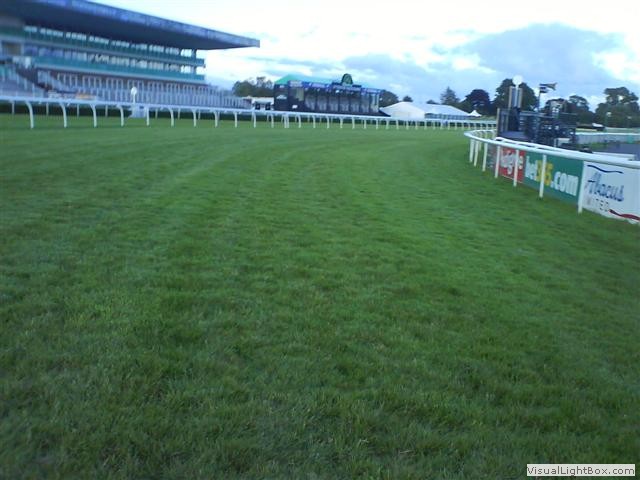 The nearest station I could get to the Churnet Valley trail was Uttoxeter, a three hour
journey from Newport. The only campsite in Uttoxeter is in the middle of the race course, the site is only
accessible on non-race days as they will not let you cross the track during meetings. I pitched
the tent around six in the evening and locked the bike to what I thought was a steel fence, but in fact
all the fences are made of plastic. I walked a short way into town for food, weatherspoons again,
the only chain establishment, you’re guaranteed to get cheap beer and reasonably priced food. This
particular time the food wasn’t up to scratch, but in fairness that was a first for me. When I came
back, I had a walk around the race course, I was surprised how rough the ground was. In fact there
were foot size holes which could easily trap and snap a human leg, I quickly ducked under the
barrier and walked around on the path.
The nearest station I could get to the Churnet Valley trail was Uttoxeter, a three hour
journey from Newport. The only campsite in Uttoxeter is in the middle of the race course, the site is only
accessible on non-race days as they will not let you cross the track during meetings. I pitched
the tent around six in the evening and locked the bike to what I thought was a steel fence, but in fact
all the fences are made of plastic. I walked a short way into town for food, weatherspoons again,
the only chain establishment, you’re guaranteed to get cheap beer and reasonably priced food. This
particular time the food wasn’t up to scratch, but in fairness that was a first for me. When I came
back, I had a walk around the race course, I was surprised how rough the ground was. In fact there
were foot size holes which could easily trap and snap a human leg, I quickly ducked under the
barrier and walked around on the path.
Day 2- Uttoxeter- Hulme End (26 miles)
I awoke in the morning with the sound of water battering the tent and thought the weather men had it wrong again, but after sticking my head out of the flap I could see the trackside sprinklers were on to water the track. The grounds keeper arrived and said he would turn them off long enough for me to pack the things away.
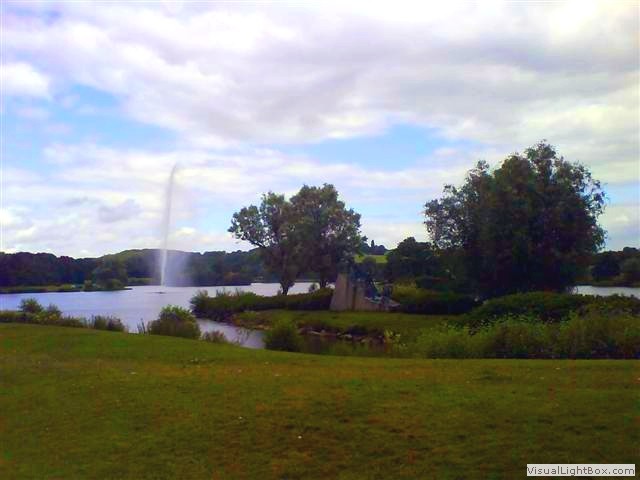 I headed for Rocester, home of the famous ‘JCB’ factory and stayed off the main roads by riding
around their lakes, passing a sculpture on an island of several men with shovels with a backdrop
of a single fifty foot water spout emerging from the lake. A little way on through the lanes was
the little village of Denstone and the start of the Churnet Valley trail. Two youngsters came past
covered in mud and this should have been a warning to me of what was ahead, but I didn’t twig. The
trail started off through remnants of a little station then onto coarse stone chippings the size of
railway ballast, I sometimes despair at the morons who sanction these things. On I went, the trail
was muddy and difficult to ride, picking my way through and between deep puddles or tree roots spidering
their way across the path. When the tree canopy opened up, the ground was firmer and the views
were pleasant.
I headed for Rocester, home of the famous ‘JCB’ factory and stayed off the main roads by riding
around their lakes, passing a sculpture on an island of several men with shovels with a backdrop
of a single fifty foot water spout emerging from the lake. A little way on through the lanes was
the little village of Denstone and the start of the Churnet Valley trail. Two youngsters came past
covered in mud and this should have been a warning to me of what was ahead, but I didn’t twig. The
trail started off through remnants of a little station then onto coarse stone chippings the size of
railway ballast, I sometimes despair at the morons who sanction these things. On I went, the trail
was muddy and difficult to ride, picking my way through and between deep puddles or tree roots spidering
their way across the path. When the tree canopy opened up, the ground was firmer and the views
were pleasant.
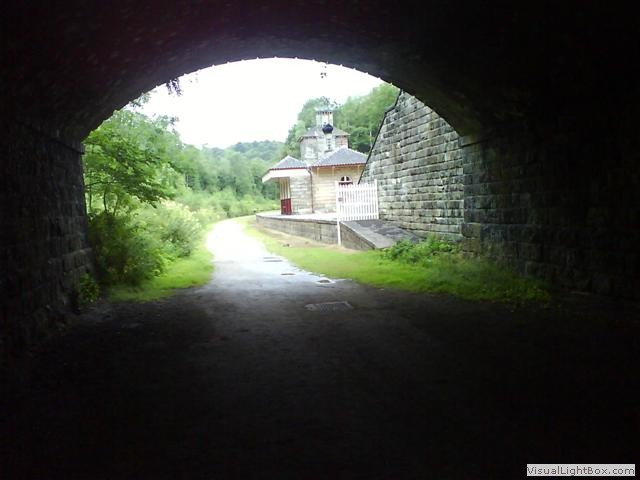 Eventually I came to a bridge and looking through it was like looking at another era, forgotten in
time, bathed in its own light was Alton station in all its glory, refurbished by the Landmark Trust.
It didn’t disappoint, but what really struck me was the length of the platform, disappearing out of
view around the curve, it could easily take one of the long modern trains of today, an indication of
the amount of people that used to use the station. On I trudged through the mud and absent of the sun
shielded by the trees. Until I reached the end of trail with another station at Oakamoor, it looked
like the track split here and went two different ways, but for me I was pointed onto the road by an
arrow on a National cycle path sign. After crossing a railway bridge over the river Churnet,
there was a pretty level crossing keeper's cottage standing at the entrance to the southern approach
cutting of Oakamoor tunnel. Now bricked up, the 497-yard Oakamoor Tunnel closed in the mid-sixties.
On ‘Google’ maps on the far side of the tunnel is the southernmost terminus of the Churnet Valley
heritage railway.
Eventually I came to a bridge and looking through it was like looking at another era, forgotten in
time, bathed in its own light was Alton station in all its glory, refurbished by the Landmark Trust.
It didn’t disappoint, but what really struck me was the length of the platform, disappearing out of
view around the curve, it could easily take one of the long modern trains of today, an indication of
the amount of people that used to use the station. On I trudged through the mud and absent of the sun
shielded by the trees. Until I reached the end of trail with another station at Oakamoor, it looked
like the track split here and went two different ways, but for me I was pointed onto the road by an
arrow on a National cycle path sign. After crossing a railway bridge over the river Churnet,
there was a pretty level crossing keeper's cottage standing at the entrance to the southern approach
cutting of Oakamoor tunnel. Now bricked up, the 497-yard Oakamoor Tunnel closed in the mid-sixties.
On ‘Google’ maps on the far side of the tunnel is the southernmost terminus of the Churnet Valley
heritage railway.
I rode through Oakamoor village and across bridge with a roaring weir on the one side, then up, and up, and up on the B1547 on a road named ‘Star Bank’. Well, this should have been a bit of a giveaway really, one; you can’t get any higher than a star and two; bank- meaning steep sided earthworks. I climbed 700ft in three miles and rode over a white sign sprayed on the road; ‘Come on Wiggo’, which I can only presume, a major tour had used the same route that I was now ascending.
Finally reaching the southernmost start of the Manifold trail at Waterhouses, where there is a cycle hire place
and cafe. I had a chat with the cycle hire chap while he made me a tea and then sat down with tea and a bun to recover
from that bathplug of a hill. I set off, all the better for a twenty minute break. The trail wasn’t over
crowed, but had enough people on it either walking dogs or cycling with their small children to make me
stop every couple of hundred yards. The path was tarmac, but for heaven’s sake, it was so bumpy, I
thought my fillings were going to rattle loose. Apart from that, the trail crosses the dry River Hamps
several times and is partitioned in by steep cliff sided rocky terrain.
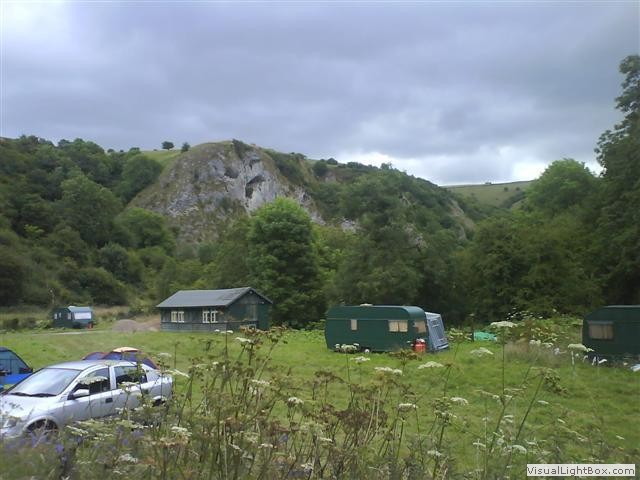 Buzzards screeched overhead along with loads of sheep barring, it was very pleasant. I passed a caravan
site which looked like it was habited by ‘tree huggers’, a phrase coined in 1730, when hundreds of Asian
Indians died while trying to protect the trees in their village from being turned into the raw material
for a palace. A few miles from the start of the trail is Thors cave, located high in a steep limestone
crag, it’s easily visible from the valley bottom.
Buzzards screeched overhead along with loads of sheep barring, it was very pleasant. I passed a caravan
site which looked like it was habited by ‘tree huggers’, a phrase coined in 1730, when hundreds of Asian
Indians died while trying to protect the trees in their village from being turned into the raw material
for a palace. A few miles from the start of the trail is Thors cave, located high in a steep limestone
crag, it’s easily visible from the valley bottom.
The dedicated trail ends at Leek road and now the original railway route is shared with a road. I stopped for a cup of tea at Wetton Mill tea rooms and asked about the mill, but the two young girls serving didn’t have a clue what I was talking about. Courtesy of good old Wikipedia- Wetton Mill was a water mill for grinding corn, and the remains of a mill stream, along with a grindstone, may still be seen, perhaps I should email them the link.
The route remains shared until the other side of Swainley tunnel and now follows the route of the Manifold River and eventually opens up to meadowland, where birds of prey hovered in mid air for what seemed ages. At the end of the trail is a cafe and a visitor centre in the old station building which has been fully restored, complete with mock beams, there’s a lovely picnic area to the rear. I moved on, just down the road and over a hump back bridge was my stop for the day; Bank house farm campsite. Near the entrance to the campsite is the old Toll House, which at one time served as a turnpike for the river crossing. The Toll House sits on part of the original bridge built in 1790, but most of it was subsequently damaged, and was rebuilt in 1819. I pitched my tent next to Manifold river (more of a brook) on luscious grass that could be someone’s front lawn. I showered and trotted across the road to the Manifold Inn, formerly called The Light Railway, despite its name; it is a 200 year old coaching inn. The food was good and so was the beer.
Day 3- Hulme End to Cromford (18 miles)
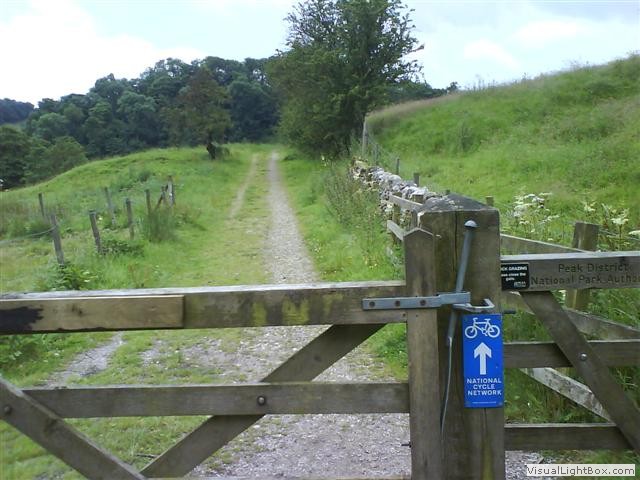 Heavy showers were predicted today (in July), and I set off under an overcast grey sky. I passed
caravan site (mobile and static) after caravan site, and rode passed a gate when the ‘Garmin’
beeped suggesting I was off route, I retraced my route and stood aghast in front of a gate to a
farm track. Okay, it looked rideable, so I continued. I turned over a foot bridge near some
interesting rock formations at Wolfscote Dale. Then the path turned left up a hill, the path
was very rocky and difficult to walk up, let alone ride. I have never been on an official National
cycle path that was so impassable, I changed from my cycling shoes to trainers and scrambled and struggled up
the hill. Eventually I got to a road, when the heavens opened up; I took a minute to absorb the
fantastic scenery. Sheets of rain could be seen drowning the mountains in the distance. After more
un-rideable lanes, at last I reached the village of Biggin, and passed under the Tissington trail.
Crossing the main A515 the NCR 548 turned onto a limestone track, at least I was off the main road.
After more walking, and pushing the bike I could see the High peaks trail in the distance, from here
I knew I could ride again. Now on the High Peaks Trail, the first point of interest was the Longcliffe
goods yard; there’s a cottage and a stone built ramp which housed temporary water tenders used to refill
the steam engines. At this height there wasn’t a sustainable water supply, so it was brought up on trucks.
Heavy showers were predicted today (in July), and I set off under an overcast grey sky. I passed
caravan site (mobile and static) after caravan site, and rode passed a gate when the ‘Garmin’
beeped suggesting I was off route, I retraced my route and stood aghast in front of a gate to a
farm track. Okay, it looked rideable, so I continued. I turned over a foot bridge near some
interesting rock formations at Wolfscote Dale. Then the path turned left up a hill, the path
was very rocky and difficult to walk up, let alone ride. I have never been on an official National
cycle path that was so impassable, I changed from my cycling shoes to trainers and scrambled and struggled up
the hill. Eventually I got to a road, when the heavens opened up; I took a minute to absorb the
fantastic scenery. Sheets of rain could be seen drowning the mountains in the distance. After more
un-rideable lanes, at last I reached the village of Biggin, and passed under the Tissington trail.
Crossing the main A515 the NCR 548 turned onto a limestone track, at least I was off the main road.
After more walking, and pushing the bike I could see the High peaks trail in the distance, from here
I knew I could ride again. Now on the High Peaks Trail, the first point of interest was the Longcliffe
goods yard; there’s a cottage and a stone built ramp which housed temporary water tenders used to refill
the steam engines. At this height there wasn’t a sustainable water supply, so it was brought up on trucks.
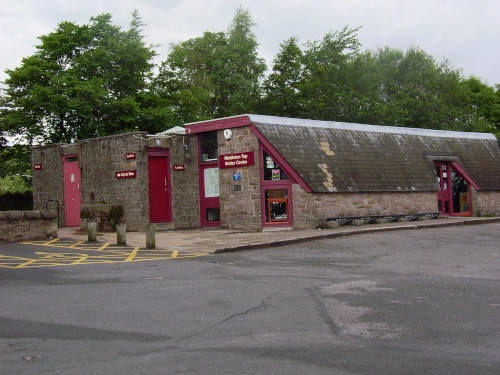 Further down the trail was Middleton Top. Here there is a cafe, cycle hire, visitor centre, and an engine
house for a towed rope section of the line. No locomotives then or now could climb the steeply inclined
rails from Cromford. The answer was to use a series of cable powered inclined planes linking long, nearly
level sections of line suitable for locomotives and trucks. To warm up I had some tea in the cafe, the
gentleman serving put on a video of the Cromford and high peak railway in action, I was surprised the line
survived until 1967. The next section of the trail, cyclists are advised to walk down, but I’d done enough
walking today so I rode down to the next engine house midway down, the views were immense, then another steep
descent into Cromford High Peaks Junction. Here there was another cafe and visitor centre. I rode along the
canal to Cromford Wharf the historic terminus of Cromford Canal. Built at the end of the 18th century, the
wharf was designed to cater for large amounts of both incoming and outgoing traffic. Just to absorb the
ambiance, I had another tea and some toast. Past Cromford Mill (which I was visiting on foot the next day)
and up a lane to my next stop for the night; Alison house.
Further down the trail was Middleton Top. Here there is a cafe, cycle hire, visitor centre, and an engine
house for a towed rope section of the line. No locomotives then or now could climb the steeply inclined
rails from Cromford. The answer was to use a series of cable powered inclined planes linking long, nearly
level sections of line suitable for locomotives and trucks. To warm up I had some tea in the cafe, the
gentleman serving put on a video of the Cromford and high peak railway in action, I was surprised the line
survived until 1967. The next section of the trail, cyclists are advised to walk down, but I’d done enough
walking today so I rode down to the next engine house midway down, the views were immense, then another steep
descent into Cromford High Peaks Junction. Here there was another cafe and visitor centre. I rode along the
canal to Cromford Wharf the historic terminus of Cromford Canal. Built at the end of the 18th century, the
wharf was designed to cater for large amounts of both incoming and outgoing traffic. Just to absorb the
ambiance, I had another tea and some toast. Past Cromford Mill (which I was visiting on foot the next day)
and up a lane to my next stop for the night; Alison house.
Alison house is a four star hotel and restaurant and has a small campsite next to the grounds. I set up the tent, washed the bike, and had a shower (I had to pay for a shower in the hotel as there are none on site). It had been a mother of a day; I averaged 6 mph, largely because of all the walking I had to do when the route wasn’t rideable, the weather wasn’t kind, and the bike was covered in white mud and so was I. Alison house was great, I had a pint and sat reading in a beautiful lounge waiting for my food to be cooked. The food was top notch, and being in pleasant surroundings at the end of this day, almost made it all worthwhile.
Day 4- Cromford (walking)- Crich- Whatstanding (6 miles)
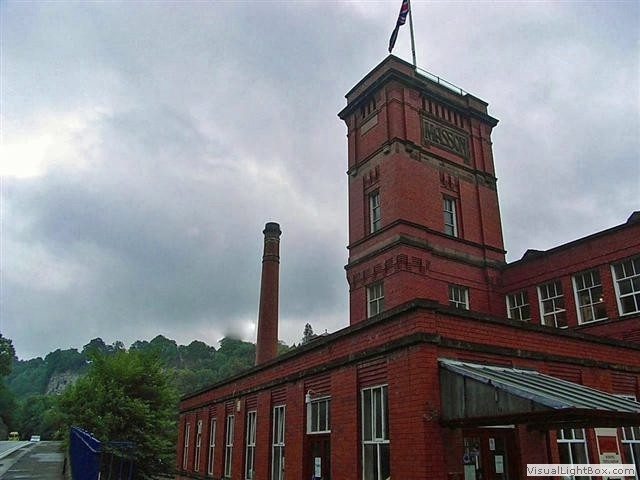 I put some stuff away and set off on foot to see the Mills, the first was ten minutes away; Masson
mill. After breakfast at the mill, there are a few options for visiting the museum, I choose the guided
tour. The chap taking us around was in period costume and gave a good demo with a live demonstration of
three working looms. It really brought home the conditions of working 12 hours a day in such noise and
dangerous conditions with dust and cotton fibres being inhaled. Children as young as 9 worked in this
factory, very young admittedly, but Arkwright didn't employ younger children unlike some of his
competitors.
I put some stuff away and set off on foot to see the Mills, the first was ten minutes away; Masson
mill. After breakfast at the mill, there are a few options for visiting the museum, I choose the guided
tour. The chap taking us around was in period costume and gave a good demo with a live demonstration of
three working looms. It really brought home the conditions of working 12 hours a day in such noise and
dangerous conditions with dust and cotton fibres being inhaled. Children as young as 9 worked in this
factory, very young admittedly, but Arkwright didn't employ younger children unlike some of his
competitors.
I walked back to Cromford Mills and was a little disappointed, part of the mill looked like it was being restored and was basically a building site. The museum was in a dank and dark basement, Masson mill is by far the better of the two. After a swift coffee, I walked back to the campsite and put the tent away and got changed into my cycling gear. I rode back along the Cromford canal, past the High peaks junction to the steam powered pump house that took water from the river Derwent below to feed the canal. My next destination was Crich tramway museum, but I was warned it was up a hill. Wow, was it up a hill, four miles climbing 500ft past Lea Bridge and through the village of Hollowway and up to Crich.
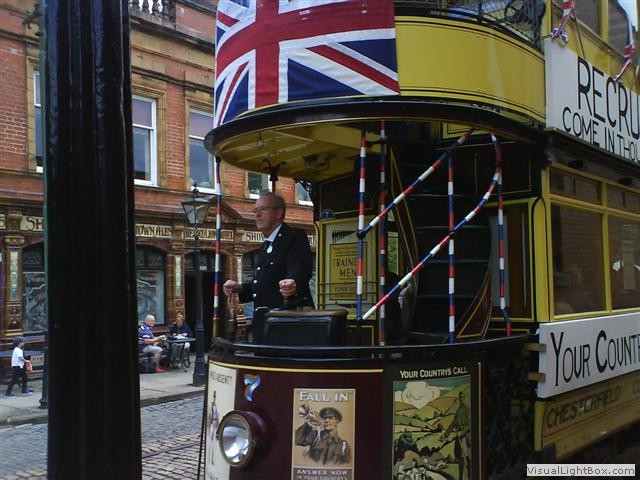 The entrance fee was as steep as the hill I’d just climbed at £16. After the shock of opening my
wallet so wide, I was ready to go in. I had pre-arranged storage of the bike inside a locked room in
the museum, the receptionist phoned the manager (no less), and he showed me where to put the bike.
The National Tramway Museum is situated within a mock town, it has a period pub, town hall, cafe,
old-style sweetshop, tram depots and exhibition halls. The museum's collection of trams runs through
the main street. Visitors are transported one mile out into the countryside and back, aboard the varied
fleet of trams. I feel the museum will have a limited appeal in the future as people who can remember
the real trams, reduce in numbers. It was worth a visit and occupied three hours of my time.
The entrance fee was as steep as the hill I’d just climbed at £16. After the shock of opening my
wallet so wide, I was ready to go in. I had pre-arranged storage of the bike inside a locked room in
the museum, the receptionist phoned the manager (no less), and he showed me where to put the bike.
The National Tramway Museum is situated within a mock town, it has a period pub, town hall, cafe,
old-style sweetshop, tram depots and exhibition halls. The museum's collection of trams runs through
the main street. Visitors are transported one mile out into the countryside and back, aboard the varied
fleet of trams. I feel the museum will have a limited appeal in the future as people who can remember
the real trams, reduce in numbers. It was worth a visit and occupied three hours of my time.
Out of the National Tramway Museum I turned left and went down an even steeper climb than I rode up, it took me less than seven minutes to reach the bottom (the pads were smoking and smelling), through a small lane and into Whatstandwell station for my train home.
The mileage may not be long enough for some riders, however, I kept it short because this was the first camping trip after the injury, and considering the atrocious weather it worked out just right. I replaced both sets of pads before I set off, but two and a half days of riding (including some very steep hills), had worn them down, the rear brake lever was almost touching the bars. The weather could have been kinder, but what did I expect, it was mid July. The views were unparalleled and so were the climbs. Some of the National cycle routes, were utterly ridiculous, something I have now come to expect. I swear the people who sanction the routes never actually ride them, that aside it was a great time away.
-
Gallery
 Why not have a look at the gallery relating to this ride. Click the image or the title.
Why not have a look at the gallery relating to this ride. Click the image or the title. -
My clavicle repair
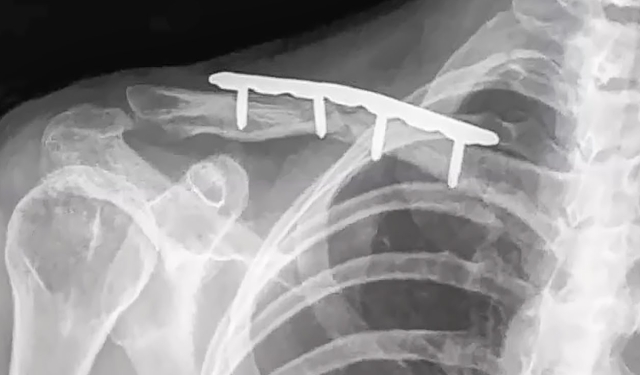 After 2 months the fracture still didn’t bond. Read how the injury progressed, click
here.
After 2 months the fracture still didn’t bond. Read how the injury progressed, click
here. -
Visit Uttoxeter- Why?
 What can one say about Uttoxeter- Well it’s changed its name more times than most towns, it has had a
racecourse since the early twentieth century, and without being unkind; that’s it.
What can one say about Uttoxeter- Well it’s changed its name more times than most towns, it has had a
racecourse since the early twentieth century, and without being unkind; that’s it. -
JCB
 Company founder Joseph Cyril Bamford began building small agricultural tipping trailers in 1945.
Today, they have 22 plants on four continents and more than 750 dealers around the world, making a
staggering amount of different types of earth movers and industrial plant.
Company founder Joseph Cyril Bamford began building small agricultural tipping trailers in 1945.
Today, they have 22 plants on four continents and more than 750 dealers around the world, making a
staggering amount of different types of earth movers and industrial plant. -
Denstone wooden train
In 2008, a kids wooden train was put on the disused Denstone station by a charity, 16 days after it was put in place it was derailed by a modern day Doctor Beeching who demanded its removal. A new home had to be found when a neighbour complained to landowner Staffordshire County Council. (Anon, 2016)
-
Alton Towers
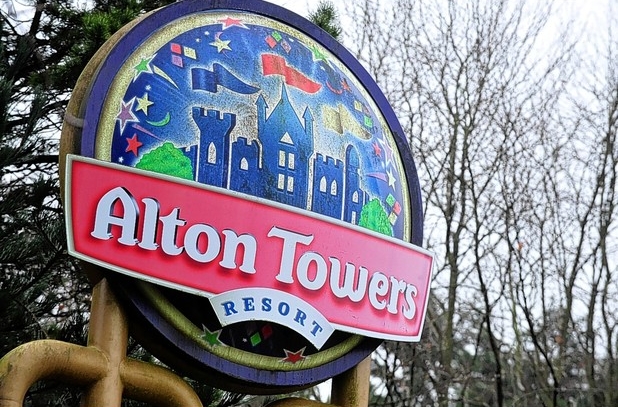 In 1924 Alton Towers (then a private mansion) was sold to a consortium that planned to run it as a full-scale
public attraction, and business boomed on the nearby Alton station. However passengers began to decline
in the 1960's, four years later, as Dr Beeching’s axe fell, it finaly closed. Incredibly today, it could
have been a massive asset to Alton Towers which is less than a mile away.
In 1924 Alton Towers (then a private mansion) was sold to a consortium that planned to run it as a full-scale
public attraction, and business boomed on the nearby Alton station. However passengers began to decline
in the 1960's, four years later, as Dr Beeching’s axe fell, it finaly closed. Incredibly today, it could
have been a massive asset to Alton Towers which is less than a mile away. -
Time team at Oakamoor
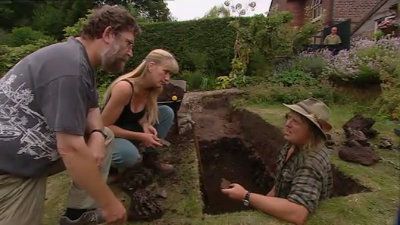 Oakamoor is a sleepy picturesque village on the banks of the River Churnet. Although it is now a
rural area, it has an industrial past which drew on the natural resources of the Churnet valley. In 2004
Oakamoor was the subject of a television programme on Channel 4’s Time Team archaeology series, which
investigated the remains of a blast furnace.
Oakamoor is a sleepy picturesque village on the banks of the River Churnet. Although it is now a
rural area, it has an industrial past which drew on the natural resources of the Churnet valley. In 2004
Oakamoor was the subject of a television programme on Channel 4’s Time Team archaeology series, which
investigated the remains of a blast furnace. -
Thors cave
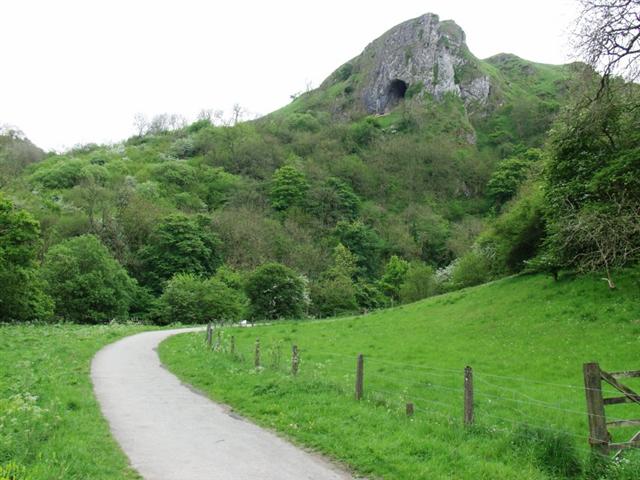 Thor's Cave is a natural cavern located in the Manifold Valley. The rock in which it is set rears up out
of the hillside like a giant fang with the cave entrance forming a hole ten metres in diameter, a sight
which is clearly visible for several miles.
Thor's Cave is a natural cavern located in the Manifold Valley. The rock in which it is set rears up out
of the hillside like a giant fang with the cave entrance forming a hole ten metres in diameter, a sight
which is clearly visible for several miles. -
Leek and Manifold Valley Light Railway
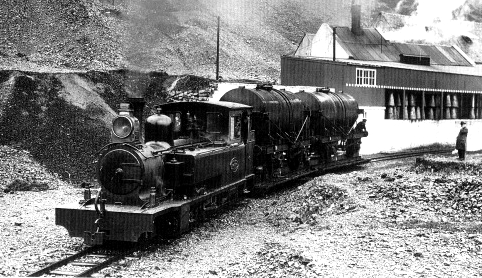 The Leek and Manifold Valley Light Railway (L&MVLR) was a narrow gauge railway in Staffordshire, that
operated between 1904 and 1934. The line mainly carried milk from dairies in the region, acting as
a feeder to the standard gauge system. The small milk wagons were pushed straight onto full size
wagons at Waterhouses.
The Leek and Manifold Valley Light Railway (L&MVLR) was a narrow gauge railway in Staffordshire, that
operated between 1904 and 1934. The line mainly carried milk from dairies in the region, acting as
a feeder to the standard gauge system. The small milk wagons were pushed straight onto full size
wagons at Waterhouses. -
The Manifold Inn
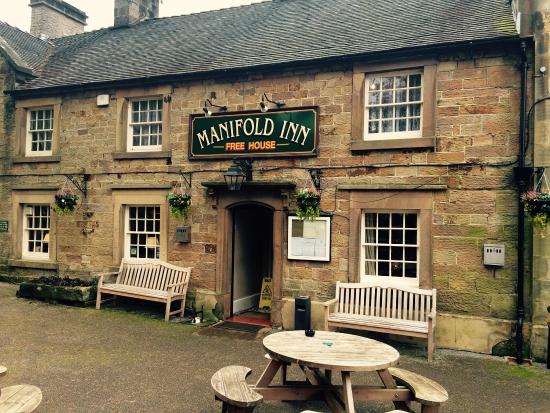 The Manifold Inn, a 19th-century, stone coaching inn, is situated by the Peak District's Manifold
River right next to Bank farm campsite.
The Manifold Inn, a 19th-century, stone coaching inn, is situated by the Peak District's Manifold
River right next to Bank farm campsite. -
Call this a cycle path?
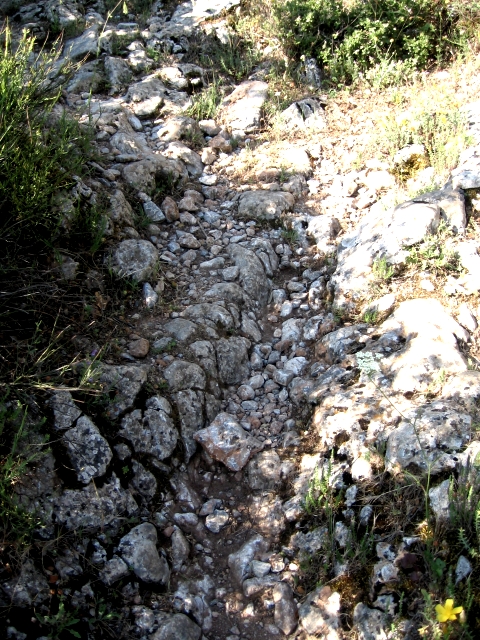 Google maps show this as a dedicated cycle path at Wolfscote Dale. Now, I’m not one to complain, but
whose idea was it to call this a cycle route? When the committees that sit around oak tables dunking
digestive biscuits in their tea discussing where to put the next cycle route, come here and take a
look where not to put a cycle path.
Google maps show this as a dedicated cycle path at Wolfscote Dale. Now, I’m not one to complain, but
whose idea was it to call this a cycle route? When the committees that sit around oak tables dunking
digestive biscuits in their tea discussing where to put the next cycle route, come here and take a
look where not to put a cycle path. -
Middleton Top Engine house
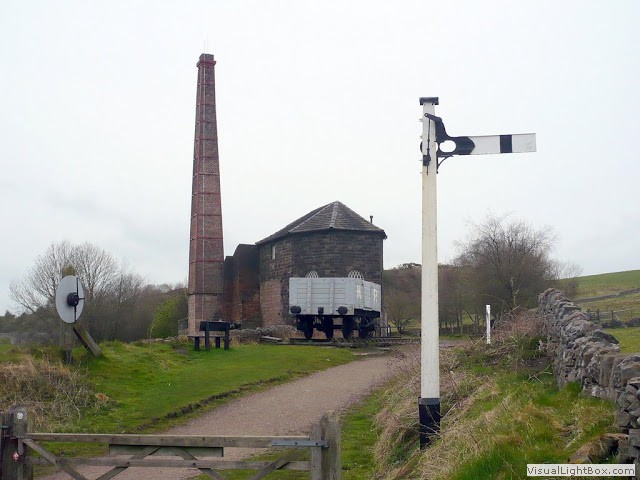 Middleton Top Engine house on the old Cromford and high peak railway is the only one of the original
winding engines on the C.H.P.R to still be in its original location atop its inclined plane, and is
still run, though sadly on compressed air not steam.
Middleton Top Engine house on the old Cromford and high peak railway is the only one of the original
winding engines on the C.H.P.R to still be in its original location atop its inclined plane, and is
still run, though sadly on compressed air not steam. -
Cromford Wharf
 The wharf stands on Mill Lane opposite Richard Arkwright's Cromford Mill, and surviving buildings include
two warehouses - one of which is now a cafe. Here Cromford Mill would load their goods ready for transport
to Derby for distribution across the UK.
The wharf stands on Mill Lane opposite Richard Arkwright's Cromford Mill, and surviving buildings include
two warehouses - one of which is now a cafe. Here Cromford Mill would load their goods ready for transport
to Derby for distribution across the UK. -
World Heritage Site
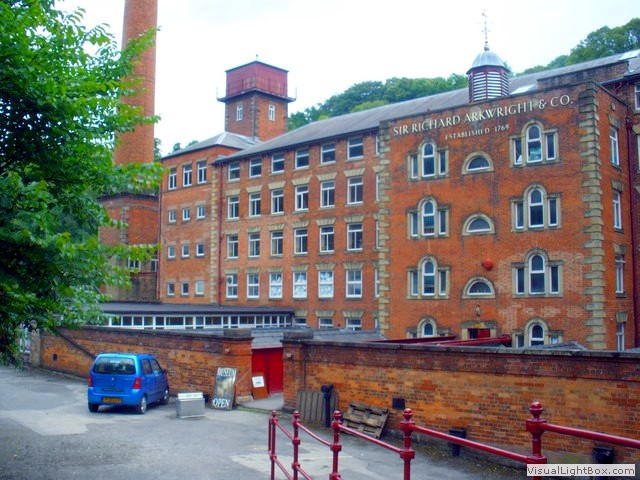 Derwent Valley Mills is a World Heritage Site along the River Derwent. It includes Masson mill, Cromford
mill, Cromford wharf, Cromford railway junction, and the canal. At Cromford mill Richard Arkwright was
the first in the World to apply water power to the process of producing cotton in the 1770s allowing
continuous production.
Derwent Valley Mills is a World Heritage Site along the River Derwent. It includes Masson mill, Cromford
mill, Cromford wharf, Cromford railway junction, and the canal. At Cromford mill Richard Arkwright was
the first in the World to apply water power to the process of producing cotton in the 1770s allowing
continuous production. -
Lea Mills
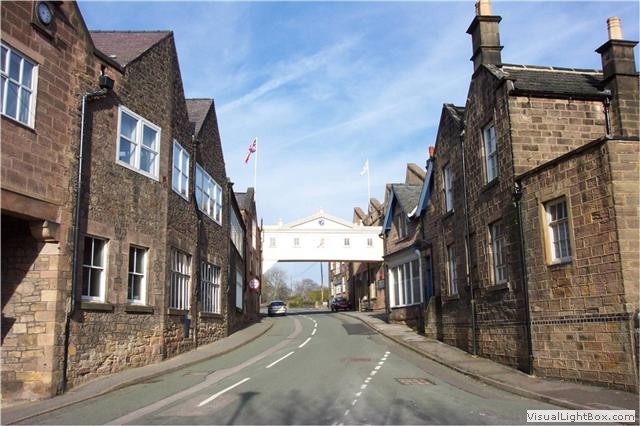 Lea Mills (at Lea Bridge near Cromford) was founded in 1784 by Peter Nightingale (the brother of Florence
Nightingale), and John Smedley. In 1825 Smedley took over the running of the mill, his name is now synonymous as
a designer label.
Lea Mills (at Lea Bridge near Cromford) was founded in 1784 by Peter Nightingale (the brother of Florence
Nightingale), and John Smedley. In 1825 Smedley took over the running of the mill, his name is now synonymous as
a designer label. -
Florence Nightingale
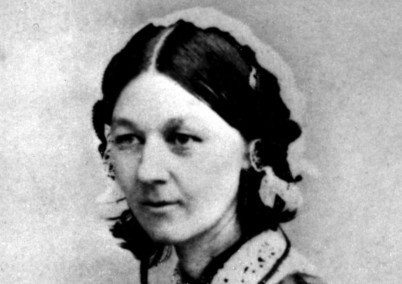 Most people know her as ‘The Lady with the lamp’, but most aren't aware of the work she did when she
came back from the Crimean War. Upon returning to the district where she grew up, she helped provide education
and healthcare to the area.
Most people know her as ‘The Lady with the lamp’, but most aren't aware of the work she did when she
came back from the Crimean War. Upon returning to the district where she grew up, she helped provide education
and healthcare to the area. -
Whatstandwell station
 It’s hard to believe Whatstandwell was a once a main line station for the Midland Railway, double tracked
and with a large goods yard going all the way to Buxton.
It’s hard to believe Whatstandwell was a once a main line station for the Midland Railway, double tracked
and with a large goods yard going all the way to Buxton. -
Bibliography
Anon, (2015). [online] Available at: http://www.stokesentinel.co.uk/Children-s-wooden-train-shunted-complaints/ story-12583078-detail/story.html [Accessed July. 2015].


 What can one say about Uttoxeter- Well it’s changed its name more times than most towns, it has had a
racecourse since the early twentieth century, and without being unkind; that’s it.
What can one say about Uttoxeter- Well it’s changed its name more times than most towns, it has had a
racecourse since the early twentieth century, and without being unkind; that’s it. Company founder Joseph Cyril Bamford began building small agricultural tipping trailers in 1945.
Today, they have 22 plants on four continents and more than 750 dealers around the world, making a
staggering amount of different types of earth movers and industrial plant.
Company founder Joseph Cyril Bamford began building small agricultural tipping trailers in 1945.
Today, they have 22 plants on four continents and more than 750 dealers around the world, making a
staggering amount of different types of earth movers and industrial plant. In 1924 Alton Towers (then a private mansion) was sold to a consortium that planned to run it as a full-scale
public attraction, and business boomed on the nearby Alton station. However passengers began to decline
in the 1960's, four years later, as Dr Beeching’s axe fell, it finaly closed. Incredibly today, it could
have been a massive asset to Alton Towers which is less than a mile away.
In 1924 Alton Towers (then a private mansion) was sold to a consortium that planned to run it as a full-scale
public attraction, and business boomed on the nearby Alton station. However passengers began to decline
in the 1960's, four years later, as Dr Beeching’s axe fell, it finaly closed. Incredibly today, it could
have been a massive asset to Alton Towers which is less than a mile away.  Oakamoor is a sleepy picturesque village on the banks of the River Churnet. Although it is now a
rural area, it has an industrial past which drew on the natural resources of the Churnet valley. In 2004
Oakamoor was the subject of a television programme on Channel 4’s Time Team archaeology series, which
investigated the remains of a blast furnace.
Oakamoor is a sleepy picturesque village on the banks of the River Churnet. Although it is now a
rural area, it has an industrial past which drew on the natural resources of the Churnet valley. In 2004
Oakamoor was the subject of a television programme on Channel 4’s Time Team archaeology series, which
investigated the remains of a blast furnace. Thor's Cave is a natural cavern located in the Manifold Valley. The rock in which it is set rears up out
of the hillside like a giant fang with the cave entrance forming a hole ten metres in diameter, a sight
which is clearly visible for several miles.
Thor's Cave is a natural cavern located in the Manifold Valley. The rock in which it is set rears up out
of the hillside like a giant fang with the cave entrance forming a hole ten metres in diameter, a sight
which is clearly visible for several miles. The Leek and Manifold Valley Light Railway (L&MVLR) was a narrow gauge railway in Staffordshire, that
operated between 1904 and 1934. The line mainly carried milk from dairies in the region, acting as
a feeder to the standard gauge system. The small milk wagons were pushed straight onto full size
wagons at Waterhouses.
The Leek and Manifold Valley Light Railway (L&MVLR) was a narrow gauge railway in Staffordshire, that
operated between 1904 and 1934. The line mainly carried milk from dairies in the region, acting as
a feeder to the standard gauge system. The small milk wagons were pushed straight onto full size
wagons at Waterhouses.  The Manifold Inn, a 19th-century, stone coaching inn, is situated by the Peak District's Manifold
River right next to Bank farm campsite.
The Manifold Inn, a 19th-century, stone coaching inn, is situated by the Peak District's Manifold
River right next to Bank farm campsite.  Google maps show this as a dedicated cycle path at Wolfscote Dale. Now, I’m not one to complain, but
whose idea was it to call this a cycle route? When the committees that sit around oak tables dunking
digestive biscuits in their tea discussing where to put the next cycle route, come here and take a
look where not to put a cycle path.
Google maps show this as a dedicated cycle path at Wolfscote Dale. Now, I’m not one to complain, but
whose idea was it to call this a cycle route? When the committees that sit around oak tables dunking
digestive biscuits in their tea discussing where to put the next cycle route, come here and take a
look where not to put a cycle path.  Middleton Top Engine house on the old Cromford and high peak railway is the only one of the original
winding engines on the C.H.P.R to still be in its original location atop its inclined plane, and is
still run, though sadly on compressed air not steam.
Middleton Top Engine house on the old Cromford and high peak railway is the only one of the original
winding engines on the C.H.P.R to still be in its original location atop its inclined plane, and is
still run, though sadly on compressed air not steam. The wharf stands on Mill Lane opposite Richard Arkwright's Cromford Mill, and surviving buildings include
two warehouses - one of which is now a cafe. Here Cromford Mill would load their goods ready for transport
to Derby for distribution across the UK.
The wharf stands on Mill Lane opposite Richard Arkwright's Cromford Mill, and surviving buildings include
two warehouses - one of which is now a cafe. Here Cromford Mill would load their goods ready for transport
to Derby for distribution across the UK. Derwent Valley Mills is a World Heritage Site along the River Derwent. It includes Masson mill, Cromford
mill, Cromford wharf, Cromford railway junction, and the canal. At Cromford mill Richard Arkwright was
the first in the World to apply water power to the process of producing cotton in the 1770s allowing
continuous production.
Derwent Valley Mills is a World Heritage Site along the River Derwent. It includes Masson mill, Cromford
mill, Cromford wharf, Cromford railway junction, and the canal. At Cromford mill Richard Arkwright was
the first in the World to apply water power to the process of producing cotton in the 1770s allowing
continuous production. Lea Mills (at Lea Bridge near Cromford) was founded in 1784 by Peter Nightingale (the brother of Florence
Nightingale), and John Smedley. In 1825 Smedley took over the running of the mill, his name is now synonymous as
a designer label.
Lea Mills (at Lea Bridge near Cromford) was founded in 1784 by Peter Nightingale (the brother of Florence
Nightingale), and John Smedley. In 1825 Smedley took over the running of the mill, his name is now synonymous as
a designer label. Most people know her as ‘The Lady with the lamp’, but most aren't aware of the work she did when she
came back from the Crimean War. Upon returning to the district where she grew up, she helped provide education
and healthcare to the area.
Most people know her as ‘The Lady with the lamp’, but most aren't aware of the work she did when she
came back from the Crimean War. Upon returning to the district where she grew up, she helped provide education
and healthcare to the area. It’s hard to believe Whatstandwell was a once a main line station for the Midland Railway, double tracked
and with a large goods yard going all the way to Buxton.
It’s hard to believe Whatstandwell was a once a main line station for the Midland Railway, double tracked
and with a large goods yard going all the way to Buxton.